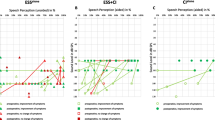Abstract
This study aims to compare the outcomes of patients with Meniere’s disease submitted to either endolymphatic mastoid shunt (ES) or tenotomy of the stapedius and tensor tympani muscles (TSTM). This is a retrospective chart review of patients treated with ES or TSTM between 2000 and 2010 and followed up for at least 12 months. The main outcomes were represented by: (1) vertigo class, hearing stage and functional level according to the American Academy of Otolaryngology-Head and Neck Surgery criteria; (2) adjustment of dizziness handicap inventory (DHI) and (3) complete and substantial vertigo control using the Kaplan–Meier survival method. Sixty-three patients met the inclusion criteria: 34 underwent ES and 29 TSTM. The baseline demographic characteristics, the hearing stage, the functional level, the DHI and hearing levels were not different between the two groups. No significant difference in vertigo class was demonstrated: 66 % of TSTM patients attained class A compared to 44 % in the ES group (p = 0.14). Kaplan–Meier survival curves specific to class A showed significant differences, favoring TSTM (log-rank test, p = 0.022). TSTM patients demonstrated significantly improved functional level (p = 0.0004) and improved DHI scores (p = 0.001). Eight ES patients (25 %) demanded a second surgical attempt compared to none in the TSTM. Aural fullness was significantly improved in TSTM group (p = 0.01), while the difference in tinnitus improvement was non-significant. Hearing preservation was significantly better in TSTM group (p = 0.001). TSTM is a safe surgical procedure, with significant vertigo control rates, and important hearing preservation rates. More patients and longer follow-up are needed to support our preliminary findings.




Similar content being viewed by others
References
Minor LB, Schessel DA, Carey JP (2004) Meniere’s disease. Curr Opin Neurol 17:9–16
Coelho DH, Lalwani AK (2008) Medical management of Meniere’s disease. Laryngoscope 118:1099–1108
Pullens B, Verschuur HP, van Benthem PP (2013) Surgery for Meniere’s disease. Cochrane Database Syst Rev 2:CD005395. doi:10.1002/14651858
Loader B, Beicht D, Hamzavi JS, Franz P (2012) Tenotomy of the middle ear muscles causes a dramatic reduction in vertigo attacks and improves audiological function in definite Meniere’s disease. Acta Otolaryngol 132(5):491–497
Monsell EM, Balkany TA, Gates GA, Goldenberg RA, Meyerhoff WL, House JW (1995) Committee on hearing and equilibrium guidelines for the diagnosis and evaluation of therapy in Meniere’s disease. Otolaryngol Head Neck Surg 113:181–185
Jacobson GP, Newman CW (1990) The development of the dizziness handicap inventory. Arch Otolaryngol Head Neck Surg 116:424–427
Brinson GM, Chen DA, Arriaga MA (2007) Endolymphatic mastoid shunt versus endolymphatic sac decompression for Meniere’s disease. Otolaryngol Head Neck Surg 136:415–421
Silverstein H, Smouha E, Jones R (1989) Natural history vs. surgery for Meniere’s disease. Otolaryngol Head Neck Surg 100:6–16
Sood AJ, Lambert PR, Nguyen SA, Meyer TA (2014) Endolymphatic sac surgery for Meniere’s disease: a systematic review and meta-analysis. Otol Neurotol 35(6):1033–1045
Derebery MJ, Fisher LM, Berliner K, Chung J, Green K (2010) Outcomes of endolymphatic shunt surgery for Meniere’s disease: comparison with intratympanic gentamicin on vertigo control and hearing loss. Otol Neurotol 31:649–655
Martin Sanz E, Zschaeck C, Gonzalez M, Mato T, Rodrigañez L, Barona R, Sanz R (2013) Control of vertigo after intratympanic corticoid therapy for unilateral Ménière’s disease: a comparison of weekly versus daily fixed protocols. Otol Neurotol 34(7):1429–1433
Hu A, Parnes L (2010) 10-year review of endolymphatic sac surgery for intractable Meniere’s disease. J Otolaryngol Head Neck Surg 39:415–421
Author information
Authors and Affiliations
Corresponding author
Rights and permissions
About this article
Cite this article
Albu, S., Babighian, G., Amadori, M. et al. Endolymphatic sac surgery versus tenotomy of the stapedius and tensor tympani muscles in the management of patients with unilateral definite Meniere’s disease. Eur Arch Otorhinolaryngol 272, 3645–3650 (2015). https://doi.org/10.1007/s00405-014-3428-1
Received:
Accepted:
Published:
Issue Date:
DOI: https://doi.org/10.1007/s00405-014-3428-1




